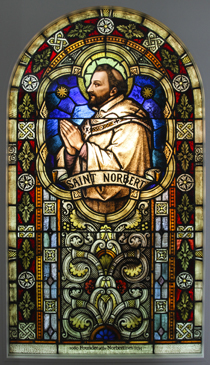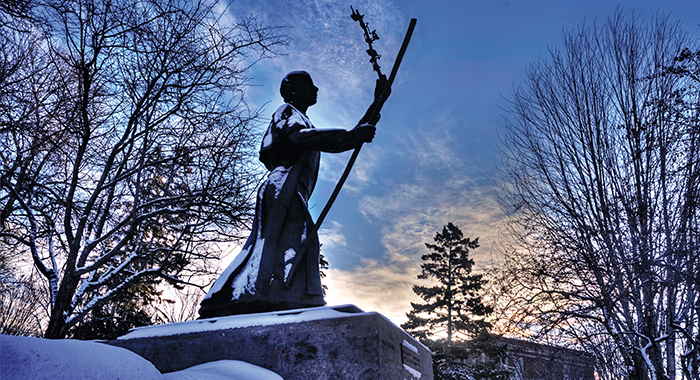Norbertines Mark 900 Years
This year marks the 900th anniversary of the church-changing, world-changing order founded by Norbert of Xanten. St. Norbert established his first monastery, in Prémontré, France, in 1121.
The international jubilee began with a November conference in Budapest and will reach its culmination this Christmas, nine centuries to the day since those first Norbertines took their Solemn Vows. The order’s abbot general is scheduled to visit SNC in May to receive an honorary degree and deliver this year’s Commencement speech.
If that schedule seems ambitious, so be it. Nine hundred years is a long time and deserves a proper feting, says Prior Emeritus Eugene Gries ’62 of Santa María de la Vid Abbey in Albuquerque, N.M. “It’s a significant benchmark, a time to celebrate with gusto!”
That Norbertine life has been around 900 years “means we have been faithful to our charism,” says the Rev. Chrysostom Baer, prior of St. Michael’s Abbey in Silverado, Calif. It means, says Abbot Joel Garner ’62 of Santa María de la Vid Abbey in Albuquerque, N.M., that “the order has been resilient during the many periods of deep turmoil over the centuries.”
It means that Norbertines have filled a need, says the Rev. Brad Vanden Branden ’09, prior of the De Pere abbey. “To be part of something that’s 900 years old – there’s something about this way of life that can stand the test of time, especially in a time of hatred and sickness,” Vanden Branden says.
Against the backdrop of the multinational jubilee, Norbertines across the United States have plans to mark the anniversary in their individual communities, too, from opening a new abbey building – which is the plan at St. Michael’s – to reviewing the life of Norbert. “I’ve already started dusting off my primary-source documents, reading the vitae of Norbert, Vita A, Vita B,” Vanden Branden says.
Even the order’s headstrong founder would have been amazed at the staying power of the Norbertine way of life, says the Rev. Andrew Ciferni ’64. Ciferni, a priest of Daylesford Abbey in Paoli, Pa., is chair of SNC’s board of trustees.
“The spiritual context of [Norbert’s] time was apocalyptic,” Ciferni says. “There was an expectation that Christ would be returning, which meant we really needed to get everybody evangelized. So I don’t think he thought that far ahead.”
Marking the anniversary, too, is Bayview Immaculate Conception Priory in Middleton, Del., where the Rev. James Herring, also a college trustee, is prior.
Resilient and relevant Though Norbert is a relatively little-known figure in the U.S., he – and the order he established – have had a big impact.
Though Norbert is a relatively little-known figure in the U.S., he – and the order he established – have had a big impact.
“With Norbertines, the impact was local,” Ciferni says. “You don’t see the impact as universally as you see it with Jesuits, Franciscans and Dominicans. But, in the Middle Ages, when these [Norbertine] abbeys were founded in the low countries, one of the things they did was develop land agronomically. They built great libraries. And they were the suppliers of lots of needs besides the spiritual. Often they were the beer makers for the area, the pharmacist or the physician.”
Garner adds, “One could argue that [the order] certainly has made its mark in the regions in which an abbey has grown up. The men that have been nourished by Norbertine spirituality have come to serve in parishes, hospitals and schools. Thousands of people have been influenced by the ministries of Norbertines.”
Though there have been between 600 and 700 Norbertine abbeys since the founding of Norbert’s first community at Prémontré, Ciferni estimates, there are only 35 today. Some were lost in the Thirty Years’ War. Thirty-two were dissolved by Henry the VIII. Ninety were closed during the French Revolution. And many were secularized by the Spanish government.
By 1835, the Norbertine order existed only in Austria, Hungary, Bohemia and Slovakia.
Eventually the abbeys in Belgium reopened and many Norbertines went to Africa, Belgian Congo and Brazil in response to pressure from the Vatican to do missionary work. But by the end of the 19th century the most significant expansion of the order was happening in the United States. In 1893, the Dutch priest and educator the Rev. Bernard Henry Pennings was sent as a missionary to the U.S. to help prevent the threatened religious defection of Belgian immigrants in the Green Bay, Wis., area. And in 1898 he founded the priory of St. Norbert and St. Norbert College, in De Pere.
Norbertines have made a lasting impact on education in the United States, Ciferni says: “What became very clear was that American bishops were very interested in schools.”
A Reforming Priest and a Key Figure in Church History
The thunderstorm that changed everything blew in suddenly as Norbert of Xanten rode his horse to the German village of Freden in the year 1115. Rain slashed mercilessly at the nobleman’s fancy coif and clothes, drenching him to the bone. Then lightning flashed, the horse bucked and Norbert went flying.
Norbert hit the ground, lost consciousness and awoke to experience a spiritual conversion that led him to become an itinerant preacher, and eventually establish an abbey and found the Norbertine order.
It was quite a change for the once-pleasure seeking nobleman, whom one medieval biography calls “frivolous.”
“Until then, I call him an opportunistic cleric,” says the Rev. Andrew Ciferni of Daylesford Abbey. “He put ordination off. He was leaving his options open – you know, maybe he could find the right lady, or whatever – and he was plugged in.
“[Then] he has this conversion experience, and it’s like boom – ‘All right, I want to be ordained a deacon and a priest on the same day,’ which is absolutely forbidden. But I think he just browbeat the archbishop of Cologne” to get what he wanted.
“It seems to me like in many ways he would have been accustomed to having things his way,” says the Rev. Brad Vanden Branden, prior of St. Norbert Abbey in De Pere. “There was a real expectation on his part that he had something to say and that people should listen.
“I get the sense he was a very zealous person. That was both good and bad. It made people uncomfortable. He called them out in public for their faults. But he had this mission to accomplish.”
After his fall from the horse, Norbert disposed of his estate and gave his wealth to the poor. He became an itinerant preacher, often traveling barefoot – even in snow and ice – and begging for bread for nourishment.
“He’s got disciples. They’re traveling barefoot in the snow. The first disciples die of overexposure,” Ciferni says.
“He’s wearing the very simple woolen robes of a monk; but he’s not a monk, and he has violated church law by being ordained a deacon and a priest on the same day. So he’s called to a council to be reprimanded, and, lucky for him, the cardinal running the council is on his side. [So] he goes down to the south of France and gets a license to preach anywhere he wanted.”
Norbert was extremely charismatic, Ciferni said. He was wealthy, handsome, thin and somewhat tall, according to an early biography. “He had a compelling way of speaking. He was like a magnet. People were drawn to him spontaneously,” Ciferni said.
In 1119, Pope Calixtus II asked the Bishop Bartholomew of Loan to look after Norbert, settle him down, and keep him in the service of his diocese. Norbert was run-down. He was asked to establish a house to recover his strength and lower his profile. He chose Prémontré, a lonely, marshy valley in France, shaped in the form of a cross.
“It’s interesting because when he became the archbishop, in a certain sense he reverted to the creature comforts of his pre-conversion period,” Ciferni says. “Because he had really no choice. Because that’s how archbishops lived. He winds up in this position of trying to keep peace between the pope and the emperor. Once again he is a reconciler and peacemaker.”
Norbert of Xanten: A timeline
ca. 1075
Norbert is born into a noble family near the Rhineland, on the left bank of the Rhine, in Germany.
1111
Norbert witnesses Emperor Henry V’s mistreatment of Pope Paschal II in Rome and is left feeling uneasy. He leaves the court and returns to Xanten to devote himself to prayer, penance, and reflection.
1115
On the road to Freden, Norbert experiences a religious conversion when he is thrown from his horse and nearly killed during a storm when a bolt of lightning spooks the animal. He is ordained, gives everything he owns to the poor, goes to the pope for permission to preach and becomes an itinerant preacher, traveling through Europe barefoot in the middle of winter.
1121
Norbert begins a community in a lonely French valley called Prémontré, with 30 canons, establishing there the first Norbertine monastery.
1126
Norbert is consecrated the Archbishop of Magdeburg in Germany.
1130
Anti-pope Anacletus II challenges the right of Innocent II to the papacy and Norbert confirms Innocent’s claim to the papacy and helps re-establish unity in the Church.
1134
Norbert is buried in Magdeburg, Germany, the church he governed as archbishop at the time of his death.
1582
Norbert is canonized.
Dec. 3, 1626
Norbert’s body is exhumed.
May 2, 1627
Norbert’s body is translated from its initial resting place in Magdeburg to its current glorious location in the Abbey of Strahov. His casket is carried in procession into the Church of the Assumption of Strahov Abbey in Prague, Czech Republic. There, it is enthroned in a place of honor above an altar in a side chapel.
Jan. 15, 2021












